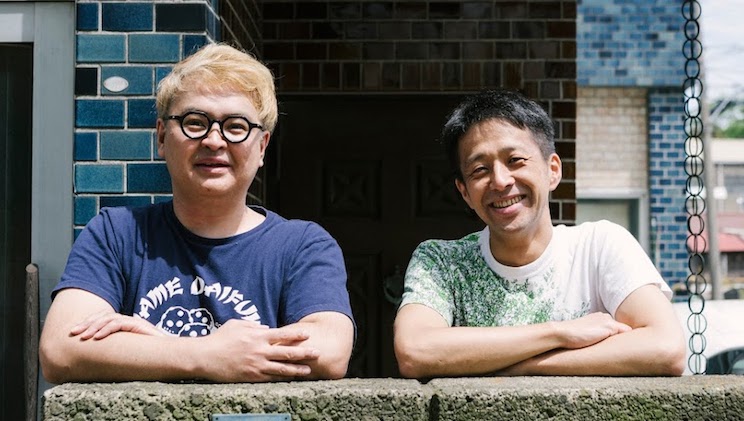Taking on the Challenge of ‘Regional Social Media’ That Creates Local Communities for Mutual Aid.
Taking on the Challenge of ‘Regional Social Media’ That Creates Local Communities for Mutual Aid.

In our current era, when “neighborly acquaintances” are increasingly rare amid urbanization, online communities are in the spotlight. A company with headquarters in Nihonbashi – “PIAZZA, Inc.” - has helped ensure the success of efforts to connect residents on the web, spark active communication, and develop real-world interactions. Precisely at this point when society’s direction is uncertain and we tend to hunker down at home, we spoke with PIAZZA, Inc. CEO and representative Mr. Kohei Yano about the thought that went into the company’s services, and he spoke about the need for mutual support within regions.
I thought of it as the “town square” the current era needs.
-First, please tell us about your history, Mr. Yano.
I majored in urban design and civil engineering at a university in Canada, when I was in school. I always dreamed of working in city building, and was thinking of trying to get hired at an urban development-related company. But I didn’t have much luck at that… In the end, I got hired at a securities firm, and after some time working in M&A and investment, I changed jobs to work at an online gaming company that operates on a global scale. I primarily managed the investment projects, there. I was mostly in charge of gaming companies with online communities as a theme, and that helped me sense major potential in mixing online and communication as themes.

PIAZZA, Inc. CEO and Representative Mr. Kohei Yano
-Did you always have a vision for PIAZZA, even before starting it?
Ever since I studied urban design, I wanted to create a “town square” (or PIAZZA in Italian) for a city. Later on, one of the factors that prompted me to actually launch a business was encountering the book Machinami no Bigaku (the beauty of urban landscapes). It has these amazing examples of Italian town squares, and the idea in it that “the importance of the town square rises as urbanization progresses” really resonated with me. Since then, I’ve always wondered if we’ll ever get a similar sort of space in Japan.
Also, in terms of physical experiences, I was once very anxious after my second child was in an accident. Then, a neighbor in my building whose name I didn’t even know said some nice things to me, and made me really happy. It made me feel strongly that it’s critical to generate opportunities for warm, human interaction especially in our era, when we all tend to be isolated.
That sort of feeling led me to launch PIAZZA, Inc. in 2015. We often get mistaken for a certain famous pizza company (laughter), but we’ve stayed with PIAZZA in the Latin alphabet and developed an app named “Piazza” in Japanese, since creating a town square for the city is our core concept.

The book Machinami no Bigaku, which left an impression on Mr. Yano (Image provided by: PIAZZA)
The opposite strategy from existing services – Tighter, deeper, and inclusive of the real world.
-Please tell us about the specific functions “Piazza” has.
To put it simply, we built functions like a regional version of Facebook into a smartphone app. People who live in the same region but who don’t know one another can exchange information – for example, like asking “which is the best hospital nearby” – or items – like saying “I can give people this thing” – and so on, and interact like people chatting around the well in ancient times. People in their 30s to 40s are the most numerous among our users, and we think that’s because it’s more common to look for community when you get married our have kids. In the Chuo City community we launched first, we’re up to about 30% of people in their 30s and 40s as users, thanks to lots of help. After starting there, we’re now developing services in around 30 regions.
-What sort of points give “Piazza” character?
There are a lot of online communities tailored to regions, but there aren’t any outstanding successes yet, including “Piazza.” So we’re taking the exact opposite strategy from our predecessors so far. For example, almost everyone so far constructed the online community structure in advance, rolled it out publicly, and invited everyone to come use it. But that doesn’t produce a lot of excitement. Just having a single digital tool won’t activate a local community. It’s not that easy. So we felt we had to change away from that approach.
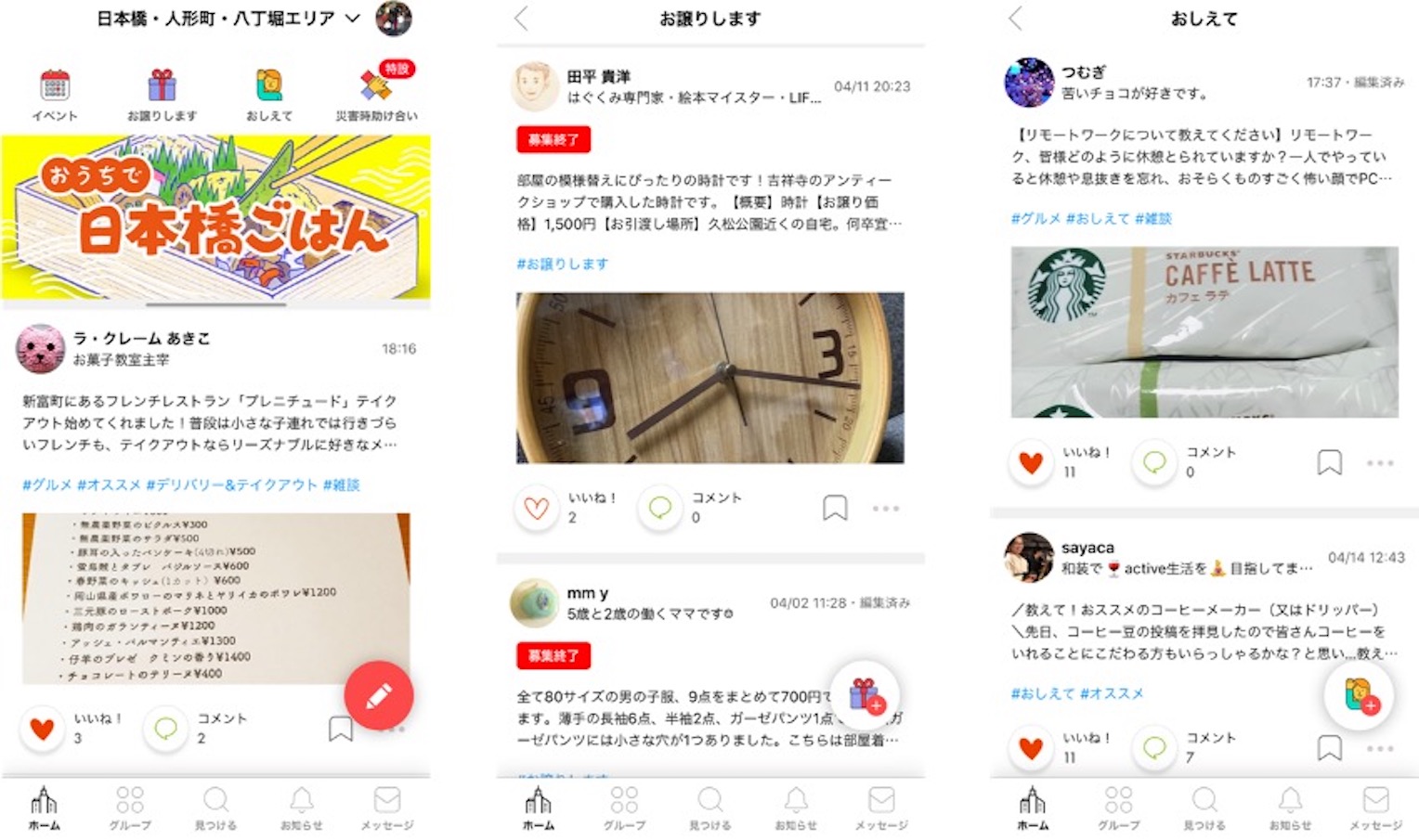
An example post from Piazza, showing active exchanges of local information (Image provided by: PIAZZA)
-I see. What sort of unique strategy are you following, specifically?
We used to use only digital tools, for a couple of years or so, but we realized how important “contact with the real world” was, as you might expect. That led us to put more focus on creating “contact points with the real world” while still being a digital service. Specifically, we’ve created positions for people as community designers, and we worked on creating places like “Flatto” which we opened in Honcho, Nihonbashi last year. This deployment of people and places is being proven to help make the community more active as we operate.


“Flatto,” opened in Honcho, Nihonbashi in 2019 as “a community space for people who live, work, and spend time in Nihonbashi.” It is equipped with lounges and studios, and in addition to accommodating a wide variety of uses, it also supports the regional town square app “Piazza”
In regard to the part with people, it’s particularly important when starting up a new community or taking in new members. For example, there’s a pretty high barrier to entry if you want to go to a club alone for the first time (laughter), but it’s not so hard if someone guides you and encourages you. It’s the same thing.
We operate the place entirely from a perspective focused on leaving the digital and going out into the real world, to create opportunities for face to face interaction. Having a facility like Flatto creates cross-currents between the digital and real worlds, and we’ve also found it energizes activity in both.
At Flatto, we also try to distinguish user voices from the wide range of posts we get every day, and to plan real-world events that suit the regional personality. We focus on “tighter, deeper, and inclusive of the real world,” using people and places, and try to be precise and thorough in adapting to suit each individual community.
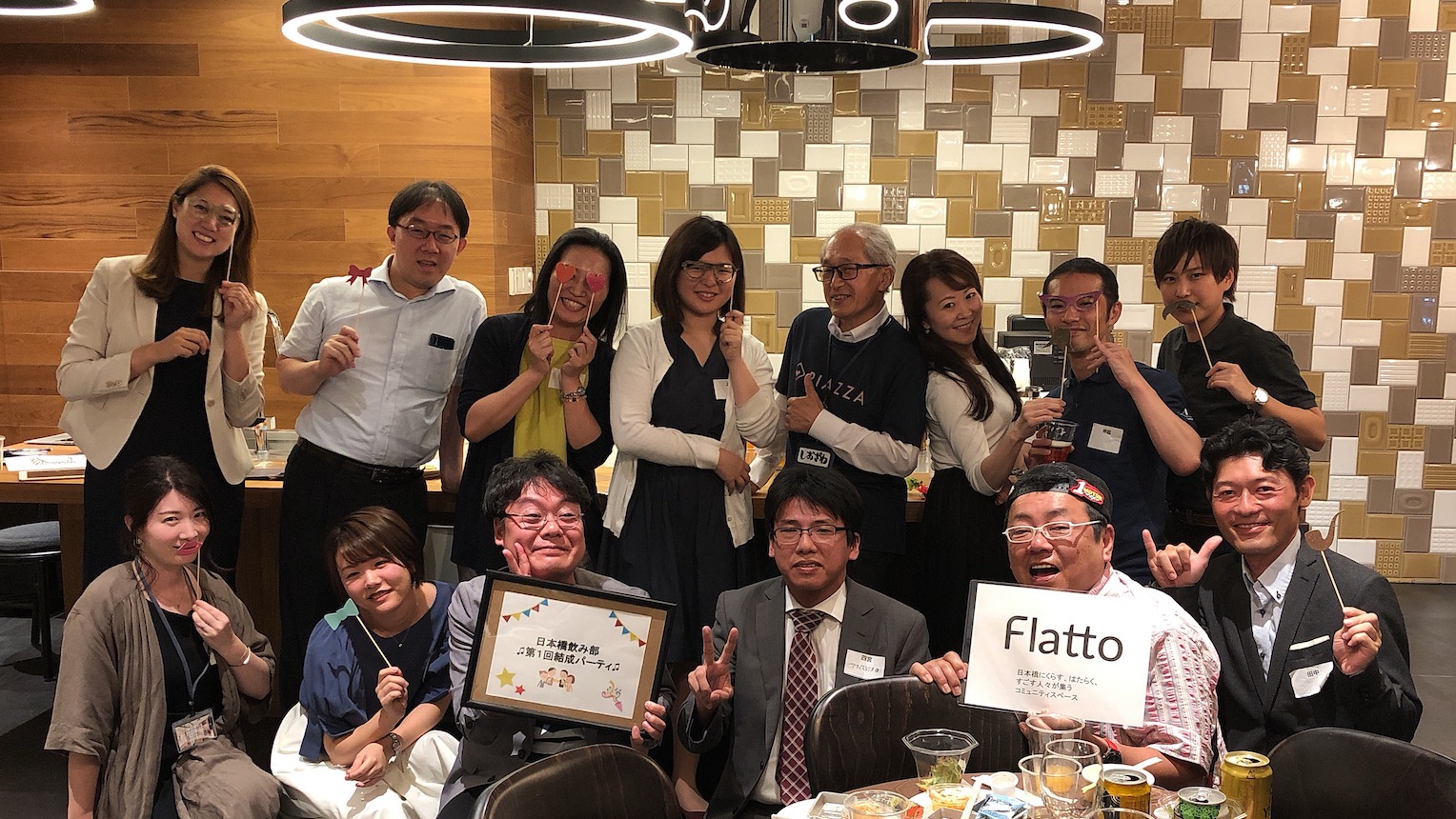
An example event at Flatto, generating a place for interactions between businesspeople (Image provided by: PIAZZA)
-So you’re seeing synergy between the digital and real worlds.
Yes, we are. “Piazza” is ultimately just the portal to a community, and it’s important to tie interaction there to the real world. So if there’s a place to actually meet, it makes digital interactions more readily initiated, themselves, and the community gets active quite quickly. If you look over the data from “Piazza,” people who participate in a real-world event after looking at the app log in three times as often the next month. To put that another way, they get three times as many chances for things to connect them to the next real-world event. This sort of virtuous cycle between the real and digital worlds causes communities to steadily mature.
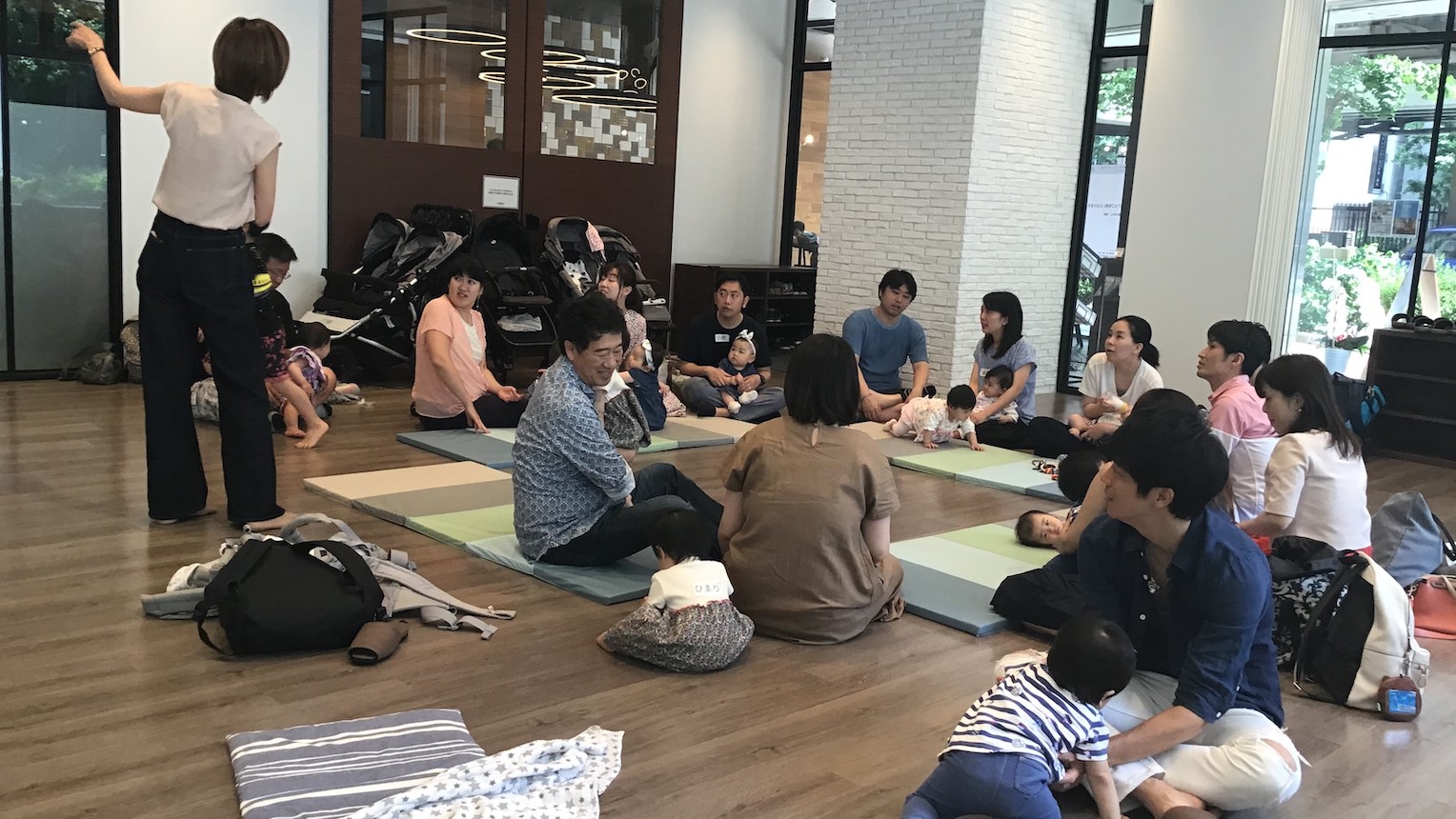
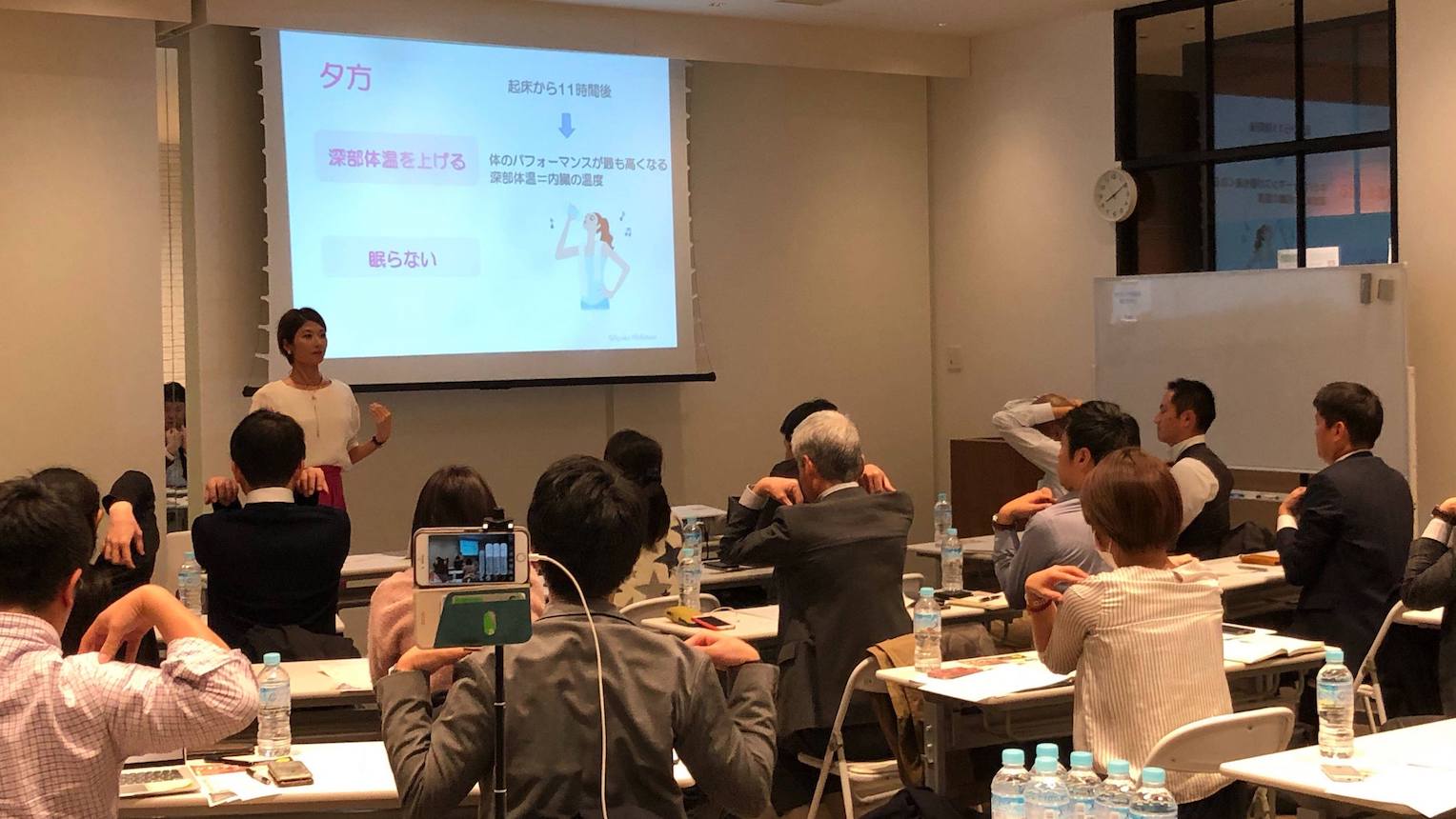
Flatto sees use from a wide range of generational groups and for a diverse set of applications (Image provided by: PIAZZA)
The new index: community value.
-You can see community activity levels from user activity data; do you have indicators for measuring community activity in “Piazza”?
Yes. Until now, the fact that “communities are hard to assess objectively” was a major issue. Even though community quality is a key point in city building, the only assessments possible were vague, like “it seems pretty active” or “I think the residents interact more than they used to.” There’s no market for business anywhere if you can’t assess that. So in our aims of creating a city that generates business which values the community, we build unique quantitative indicators for assessing community activity levels, which we call “community value.” They measure things like “number of connections” and “quantity of activity (participation/contribution)” and so forth between residents.

-Are there any trends in community value according to city?
There isn’t a major gap, but newly-developed areas in the city center tend lower, while suburban commuter towns tend to be a tiny bit higher. That’s probably because new developments are too convenient, giving residents the same experience as a big city. I think that it might be because the sense that “I have to get out of this city somehow” is weaker there. But whatever type of city we look at, we find there’s a lot we can contribute toward creating a richer community there.
-How do you use this indicator, specifically?
Determining a community value lets us compare a place with another city, or visualize a city’s characteristics quantitatively.
Because we can do that, we often allow people who need to analyze city building comprehensively – which means the government and developers and so forth – use our data. For example, the government currently has three big worries. The first is a lack of places to provide the younger demographics with information through, with neighborhood councils on the decline. The second is a lack of tools for strengthening self-government among residents – which is vital - due to inability to keep up with and address resident inquiries. And the third is the limits on how active government-led communities can be. City building is now transitioning from an era of hard, physical measures to soft, intangible measures. Rather than the work ending when a building or apartment block goes up, they now have to contend with invisible resident satisfaction levels impacting city value. So the government has a strong sense of how important soft measures are.
With that going on, we feel there is a big role for “Piazza” to fill, and we can find points that need improvement in a city by analyzing community value. For example, we can even build on and apply out successful efforts in Nihonbashi for the city of Musashi Kosugi. We also run surveys across all of “Piazza” and compare responses by city, and have produced some cases that are useful for setting government city building policy.
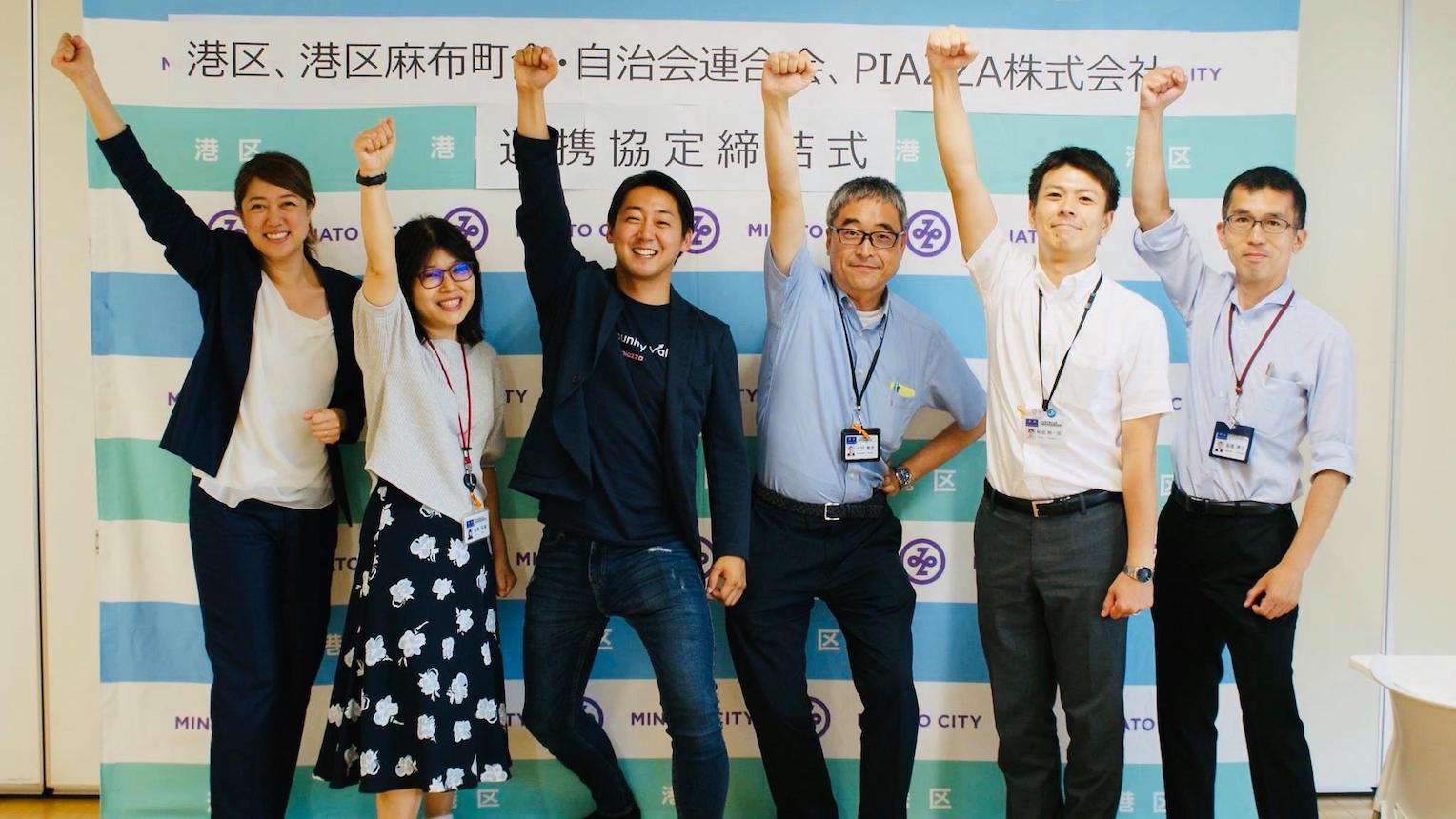
Uniting with the government as a team for city building (Image provided by: PIAZZA)
-It’s novel to think of laterally deploying city building projects to other cities.
There was also a case where all the restaurants in San Sebastien in Spain switched to open source register software for the roll-out of local Basque cuisine. What we want to do really is make the expertise to support city building open source. Rather than having cities competing with each other, I want to help spread success cases from any city in order to systematically improve all Japanese cities.
-That’s a wonderful thought. It seems like you could use this for marketing and so forth, as well as city building.
Yes, we could. For example, we use it for local advertising. They say the local advertising market is about 1 trillion yen in scale, but they also say it’s still a challenge to do high-precision marketing in it. So the sector uses a lot of printed sales promotions, like folded ad inserts and so forth. On that front, we feel that we can help expand our success cases in certain cities to others if we can match to targets with clear affiliations and needs and perform quantitative analysis on community value like “Piazza” does.
The local communities people need right now.
-I think people are revisiting their ideas of what a community should be, currently. I think that they treasure online communication in that equation, but do you feel any changes in that, Mr. Yano?
I don’t sense any major shifts in anything within communities. But when I talk with users, I do sense that the need for communities is rising. Partially due to the impact of self-quarantine measures, it feels like everyone’s sphere of activities has suddenly constricted back to where they live. I think it’s fascinating that we’re seeing an increase in male users, possibly because they’re now thinking of the area they live in. We’re seeing increased rates of new registrations overall, too, and activity is increasing.
-The atmosphere on other social media is a bit fraught right now, with people blowing up at each other over mask and food hording. Meanwhile, the topics on “Piazza” feel positive and forward-thinking, with people talking about things for “after Coronavirus is done.”
Just like other social media, we’re seeing more exchanges on how “there’s no toilet paper,” or that “they have it at this store.” But people on “Piazza” get along without fighting so well that it’s surprising. People sometimes get a bit ruffled, but it’s like they become better friends than ever after a moment of conflict (laughter). That’s because “Piazza” isn’t fully anonymous, and people feel they might be talking in front of their neighbors. So I think that helps everyone to be polite and considerate, and focus on communication.
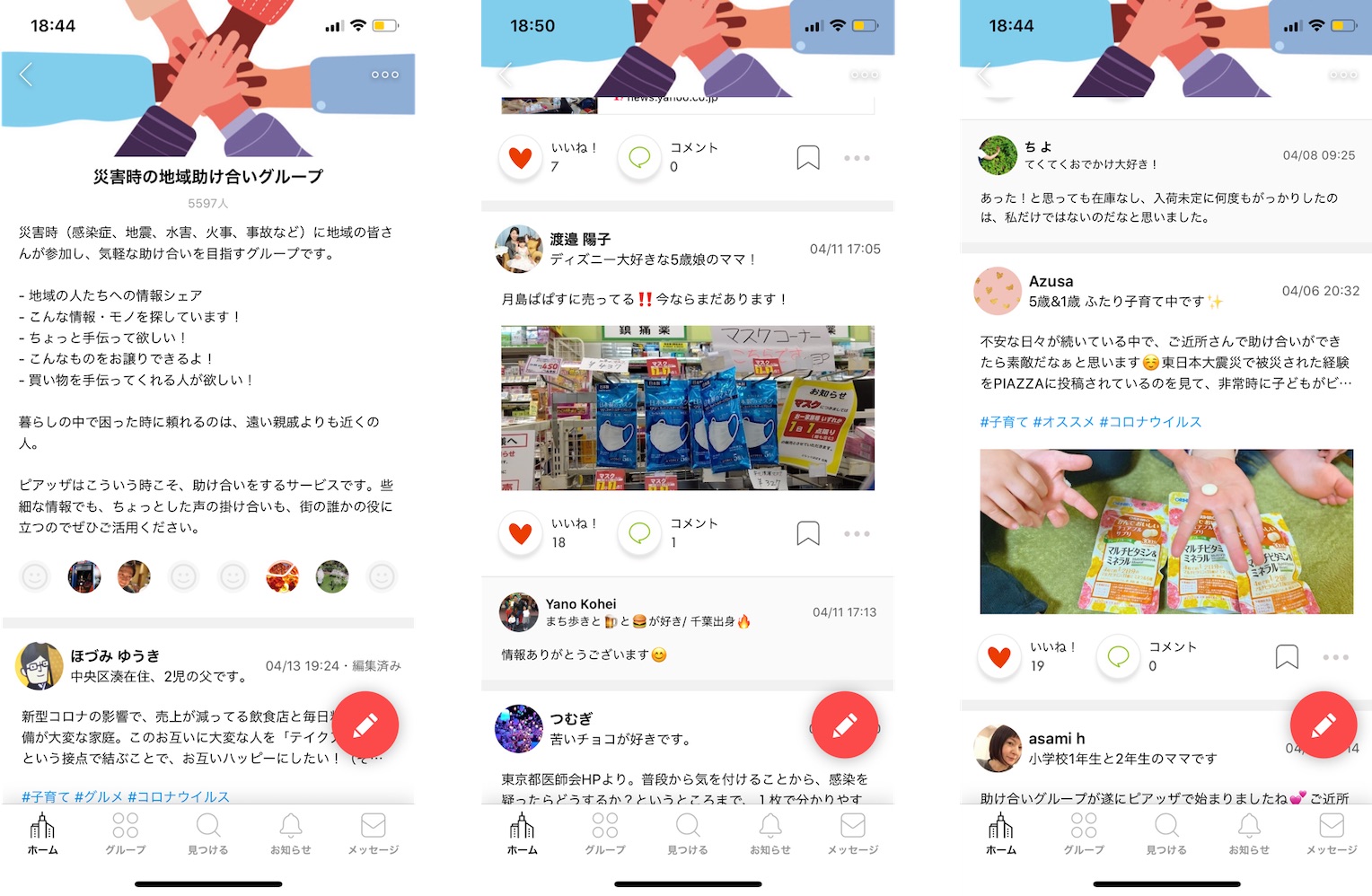
The special “disaster mutual aid” groups launched as of April 22 (Image provided by: PIAZZA)
-It’s reassuring to have somewhere with a comfortable atmosphere that compiled information on the real world near you, when there’s an emergency.
A lot of government representatives have been obsessively checking exchanges in the community, lately. It’s becoming a real-time data source on what residents need and what’s on their minds.
We can’t do city building on our own; it only works when you collaborate with the people who actually implement policy. We want to work as a team with the government and developers, so I’m delighted to see that sort of development. The “Piazza” communities can contribute a lot particularly right now, when immediate responses to resident needs are required.
City building that began in Nihonbashi, and its spread worldwide.
-Is there anything you want to work on next, after this?
Well, it’s not really like we started our current business out of a desire to create a regional social media service, in the first place. So I think of our current state as phase one. After making a regional social media service, we next want it to become a “regional service platform.”
Japan currently has all sorts of services, but only a very few perform local matching. For example, with baby sitters. In Japan, we typically contact an intermediary contractor and ask for someone to be dispatched, but it’s normal for neighborhood students to handle the job in the US. Actually, almost 100% of my classmates at the US high school I went to had worked as baby sitters. And what’s more, it was rare for their to be any intermediary contractor; it was done casually with local bulletin boards and word of mouth, with people saying “let’s check in on that woman, she’s a mother and seems to be having trouble.” They had local CtoC businesses.
I think it would be great for Japan to adopt that sort of setup, and to go even further, I think it would be ideal for it to be mutual, with everyone acting as both service providers and receivers. I want to build a world where people accept regional mutual aid as economic value. So building up “Piazza” as a service platform as we are now is what we think of as our phase two.

-There do seem to be a lot of opportunities for business that one would have better insight on with increased regional focus. Do you have a phase three in mind, too?
I want to contribute to real estate development. I mentioned earlier that city building is transitioning from soft to hard measures, but securing a community from the start when doing new urban development seems like it would greatly improve the value of the city itself. While we’ve only had limited KPIs like land prices and population and so on up to this point, adding a quantitative indicator for soft features like community value seems like something that would allow for truly modern city building.
Also, I want to expand our next-generation city building model overseas eventually, too. If it can succeed in Tokyo – one of the largest and most mature cities in the world – it can definitely apply to other cities around the world, and that makes me want to get a precise fix on them and put it to use.
People are kind. We should all lean on our communities more.
-With the importance of community on the rise right now, do you have any messages you’d like to share with our readers?
I think that it’s that “people are surprisingly kind.” To be honest, when we first made this service I wasn’t assuming that people would communicate as kindly as they do on “Piazza.” But we found that when someone needs help someone else steps in to help them, and that mutual aid will occur even without rewards, especially between people living in the same area. People may be more physically distant from one another with the quarantine underway, but they’re kind by nature, so there are always people ready to extend a helping hand when there’s a need. So whether it’s regional, work, or family or whatever, I think any community will do as something I’d want people to use to “lean on others” when they have problems. Never forget you’re not alone, and help each other out along the way.
Interview and text: Minako Ushida (Konel) Photography: Daisuke Okamura
PIAZZA, Inc.
A next-generation city building company that leverages technology in its role. In addition to developing and operating the regional town square app “Piazza” in around 30 cities in the business of digital communities, PIAZZA also jointly operates the childcare support facility “Growth Link Kachidoki” in Kachidoki, Chuo City in the field of real-world business. PIAZZA also opened “Flatto Nihonbashi” in April 2019 as “a community space for people who live, work, and spend time in Nihonbashi.”
